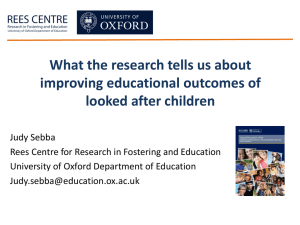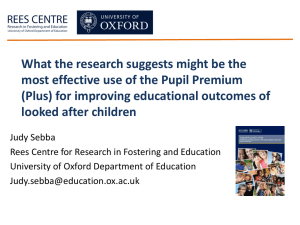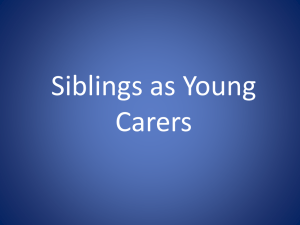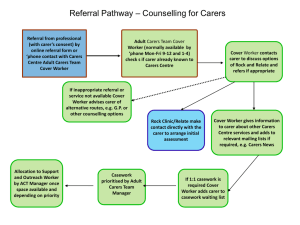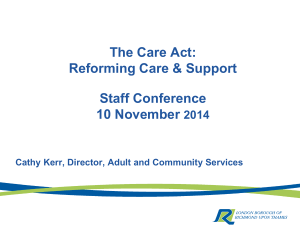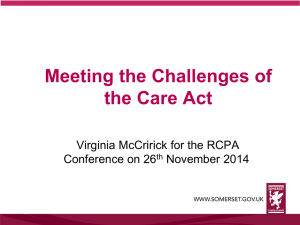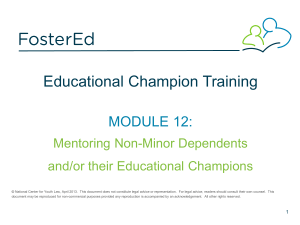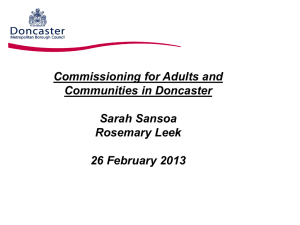What does research suggest about supporting
advertisement
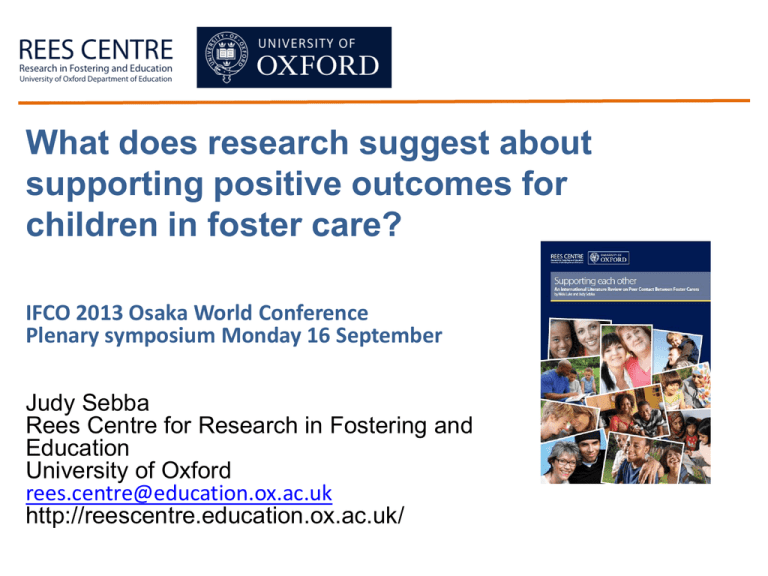
What does research suggest about supporting positive outcomes for children in foster care? IFCO 2013 Osaka World Conference Plenary symposium Monday 16 September Judy Sebba Rees Centre for Research in Fostering and Education University of Oxford rees.centre@education.ox.ac.uk http://reescentre.education.ox.ac.uk/ What I will cover The aims of the Rees Centre What is the provision in England? Some outcomes of children in care Current research at the Rees Centre What supports positive outcomes for children in foster care? Implications for practice and ways forward Rees Centre for Research in Fostering and Education The Rees Centre aims to: • identify what works to improve the outcomes and life chances of children and young people in foster care We are doing this by: • reviewing existing research in order to make better use of current evidence • conducting new research to address gaps • working with service users to identify research priorities and translate research messages into practice Centre is funded by the Core Assets Group, an international children’s services provider. Provision for children in care in England • 67,050 children in care; • 50,260 (75%) in foster care of which 6% are in kinship care; • 9% in children’s homes, secure units & hostels; • 4% placed for adoption; • 12% other includes residential (special) schools; • 32% fostered children placed outside of their area; • 39% of fostered children are placed by independent providers. Reasons for child placement (source DfE, 2012) Unacceptable behaviour 2% Family dysfunction 14% Acute family stress 9% Parent illness or disability 4% Child disability 3% Absent parenting 5% Abuse or neglect 62% Foster carers in England • Under-35s, some ethnic groups & men are under-represented among foster carers. • Minimum weekly foster care allowance in 2013/14 for a baby £116 (more in London), Minimum weekly allowance £205 for caring for a 16-17-year-old in London. • Overall number of carers sufficient but geographical spread & type of placement (e.g. teenagers) don’t match those needed. Some outcomes of children in care in England • Children in care have much poorer educational outcomes than other children in every country; • 15% achieve expected grades at 16 years compared to 59% of all children – a gap of 44%; • Only 8% access HE compared to > 50% of general population; • educational experiences and outcomes contribute to later health, employment (22% unemployment rate), involvement in crime (27% of those in prison have been in care). 11 The longer in care, the better the performance (source DfE, 2011) Key Stage 4 performance by length of time in care 70 65.0 62.3 60 55.8 55.1 5+ GCSEs at grades A*-G 51.2 5+ GCSEs at grades A*-C Percentage achieving 50 44.0 5+ GCSEs at grades A*-C including English & mathematics 40.7 40 30.0 30 33.4 28.4 25.0 20.5 20 10 31.9 8.4 0 12-18 months 18.6 16.4 9.0 10.2 18 months - 2 years 2 - 3 years 11.6 3 - 4 years Length of time in care 13.8 4 - 5 years 5 - 6 years 15.0 6 years or more 10 The less changes in placement, the better the performance (source DfE, 2011) Key Stage 4 attainment for looked after children by stability in period of care Key Stage 4 attainment for looked after children by placement stability in year 35 45 30 35 30 25 20 38.6 15 29.8 22.5 10 14.5 Percentage achieving 5+ A*-C grades Percentage achieving 5+ A*-C grades 40 25 20 15 31.9 10 16.5 18.2 5 5 0 1 2 3 Number of placements during period of care More than 3 8.2 0 1 2 3 Number of placements in year More than 3 So we need research that tells us… • How to recruit more foster carers who want to foster older, challenging, disabled or sibling groups; • How to support carers more effectively to spread positive messages, increase retention & placement stability; • How to develop resilience of the young person through support from carers, siblings, carers’ own children and other agencies including schools. Why people become or do not become foster carers: main findings from review of 32 studies • Knowing other foster carers or, less often, contact with a fostered child or young person; • Myths about fostering in the general public put them off fostering – need better information; • Appropriate support for carers, including them as part of the ‘team’ sends positive messages to those who might foster. Why people become foster carers: other findings • Altruistic reasons e.g. ‘loving children’ & wanting to make a difference; • Extending own family/providing sibling for lone child, personal experience of being fostered or parents fostering, wanting home-based employment; • Income generation not reported to be a principal motivation to foster, though covering costs and replacing income from previous employment important; Why people inquire about fostering: a study in 10 fostering services over 9 weeks • Foster carers are now interviewing > 150 people of the 584 who inquired about fostering: 7% screened out - no spare room; 34% screened out for other reasons. • Some fostering services put people off fostering by responding too slowly or enforcing ‘local’ rules. Peer support between foster carers: review • 33 studies from UK, USA, Australia, Canada, New Zealand and Ireland; • Only 4 studies examined links between peer contact and outcomes for carers, children and placements: – Increased retention of carers (Rhodes et al., 2001; Sinclair et al., 2004) – more positive attitude to fostering (Sinclair et al., 2004) – lower likelihood of depression (Cole & Eamon, 2007) – decreased placement disruptions (Northwest Institute for Children and Families, 2007) Increasing the benefits of foster carer peer support Four approaches that had some evidence of working: - Mentoring/buddying systems On-line support Mockingbird Family Model Some local carer support groups Evaluation of interventions on peer support between carers The Rees Centre is evaluating the impact of mentoring (in one service) and local groups (in 3 services) on: • Carer stress; • Relationship between child/carer; • Feelings about support from other carers; • Retention and placement stability. Siblings Together • 30 children placed separately siblings meet siblings with ‘volunteers’ monthly for activities; • Evaluation: interviewing young people (about siblings, well-being, belonging), carers, volunteers, social workers, project managers. • Carer interview explores: What is known about sibling relationships; Why child was referred by social worker; Effects on child of meetings between siblings; Expectations & challenges; Involvement of carers in arrangements. Review of selection & assessment instruments • Instrument not used by itself to accept or reject an applicant; • Can identify strengths and areas for training and/or support; 3 types of instrument identified: i) Competency based – e.g. BAAF Form F; ii) Questionnaires – e.g. Casey Foster Applicant Inventory focuses on child development, relationship with agencies; iii) Casey Home Assessment Protocol focuses on physical health, parenting style, cultural competency; • How applicable to other cultures/singles/LGBT applicants? • How do we know that these instruments ‘work’? Lack of longer term outcome measures on applicants. The impact of fostering on carers’ own children: emerging findings from review (led by Ingrid Höjer) • 13 studies – 2 US, 7 UK, 2 Canada, 1 Belgium, 1 Sweden; • Participation of carers’ own children limited but increases with age of child; • Information/preparation of carers’ own children before fostering begins improves subsequent relationships; • Perceptions of fostering mainly positive but decreased access to parent’s time, conflicts, stricter rules & less personal space; • More caring & empathic; • Increased sense of responsibility and commitment. Review of risk and protective factors in educational outcomes: early findings (Aoife O’Higgins) 10 studies from US, England & Canada: • Being in care not a risk factor for poor educational outcomes (Berridge 2012); • Early experiences of maltreatment/neglect, poverty before entering care, profound effect on educational outcomes; • For older children, longer in care, the better the outcomes; • Protective - Mentors, maximizing placement and school stability, conducting strengths-based assessment, aggressively pursuing educational supports, and treating mental health problems (Pecora 2012). Some implications for practice and ways forward • Recruitment strategies – role of existing carers, providing good information, targeting; • Review strategies for carer support - retention & placement stability influence outcomes for children; • Develop sibling contact and for evaluate outcomes; • Review use of selection instruments do they predict effective carers? • Prepare carers’ own children for fostering; • Develop relationships between carers and schools. How the Rees Centre tries to get research into policy and practice and how you can be involved • Tell us about your research priorities & register expressions of interest in future possible research • Look at the reports & recorded seminars on our website http://reescentre.education.ox.ac.uk/ • Join our mailing list - receive newsletters 5 times/year rees.centre@education.ox.ac.uk • Comment on someone else’s blog or write a blog or a piece for our newsletter • Follow us on Twitter - @ReesCentre Team Parenting for Children in Foster Care: A Model for Integrated Therapeutic Care Jeanette Caw with Judy Sebba Foreword by Professor Robbie Gilligan November 2013 How can professionals work together with foster carers to create stable and therapeutic foster placements? Let’s not underestimate the long-term damage of not using the evidence I feel due to the lack of experienced and dedicated foster carers to deal with more difficult cases and behaviours I am at a personal and unfair loss, which is why foster carers are so important… I can comment first hand and say that residential care placements just aren’t right for some young people and once in one they are often exposed to a lot of unpleasant and criminal activities. In a foster home I feel I would have eventually thrived given support and perseverance. I’ve had some fantastic foster carers but none of them ever over 2 years. Kurtis, care experienced, blog on the Rees Centre website References • Berridge, D. (2012). Educating young people in care: What have we learned? Children and Youth Services Review, 34(6), pp.1171–1175. • Cole, S. A., & Eamon, M. K. (2007). Predictors of depressive symptoms among foster caregivers. Child Abuse & Neglect, 31(3), 295-310. • DfE (2011). Raising the aspirations and educational outcomes of looked after children: a data tool for local authorities. http://www.education.gov.uk/childrenandyoungpeople/famili es/childrenincare/a00192332/ • DfE (2012). Statistical First Release. London, DfE. https://www.gov.uk/government/uploads/system/uploads/at tachment_data/file/219210/sfr20-2012v2.pdf References continued • Northwest Institute for Children and Families (2007). Mockingbird Family Model project evaluation [pdf] Available http://www.mockingbirdsociety.org/images/stories/docs/MF M/nwicf_2007-5_report.pdf • Pecora, P. (2012). Maximizing educational achievement of youth in foster care and alumni: Factors associated with success. Children and Youth Services Review, 34(6), 1121– 1129. • Rhodes, K. W., Orme, J. G., & Buehler, C. (2001). A comparison of family foster parents who quit, consider quitting, and plan to continue fostering. Social Service Review, 75(1), 84-114. • Sinclair, I., Gibbs, I., & Wilson, K. (2004). Foster carers: Why they stay and why they leave. London: Jessica Kingsley.
